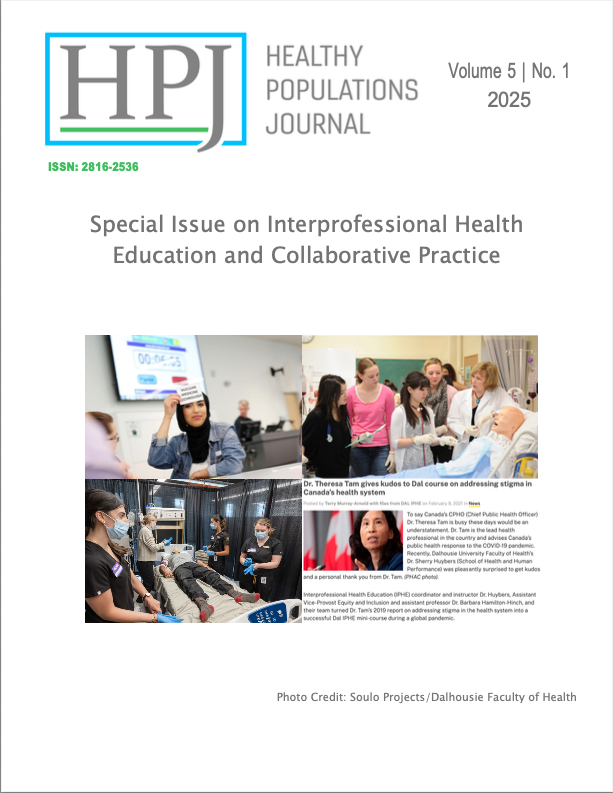Identifying Factors That Influence How Pediatric Patients or Their Caregivers Decide to Present to an Emergency Department: A Scoping Review Protocol
DOI:
https://doi.org/10.15273/hpj.v5i1.12297Keywords:
Decision Making, Choice Behavior, Emergency Medicine, Pediatric, Universal Health CareAbstract
Objective: To map and describe the extent and type of evidence in relation to factors that influence how pediatric patients or their caregivers decide to present to an emergency department (ED). Introduction: Studies in countries with universal health care systems have suggested that while patients may consider using services outside of the hospital for care, they often end up presenting to an ED. Understanding how pediatric patients and caregivers decide to present to an ED can inform future health care design to mediate decisions before an ED presentation. Inclusion criteria: Literature will be included if it assesses patients between zero and 17 years who present to the ED and reports findings from the patient’s or caregiver’s perspectives. Studies eligible for inclusion are those that focus on ED presentations in a country with universal health care, Organisation for Economic Co-operation and Development (OECD) membership, and classification as a high-income country. Studies that focus on patients transferred to the ED from a residential or correctional facility will be excluded. Methods: A scoping review using JBI methodology will be conducted. A preliminary search indicated no scoping reviews in this field have been carried out. CINAHL, MEDLINE ALL, PsycInfo, and Embase will be searched with no date limits. No language restrictions will be applied. Data will be extracted using a standardized form. Articles will be screened and data extracted by two independent reviews, with conflicts resolved by a third reviewer or through discussion. Data will be analyzed through tables with an accompanying narrative summary and PRISMA-ScR.
References
Agarwal, S., Banerjee, J., Baker, R., Conroy, S., Hsu, R., Rashid, A., Camosso-Stefinovic, J., Sinfield, P., & Habiba, M. (2012). Potentially avoidable emergency department attendance: Interview study of patients’ reasons for attendance. Emergency Medicine Journal, 29(12), Article e3. https://doi.org/10.1136/emermed-2011-200585
Aromataris, E., Lockwood, C., Porritt, K., Pilla, B., & Jordan, Z. (Eds.). (2024). JBI Manual for Evidence Synthesis. JBI. https://doi.org/10.46658/JBIMES-24-01
Canadian Agency for Drugs and Technologies in Health. (2023). CADTH Health Technology Review recommendation: Emergency department overcrowding in Canada. Canadian Journal of Health Technologies, 3(11).
Canadian Institute for Health Information. (2024). NACRS emergency department visits and length of stay. https://www.cihi.ca/en/nacrs-emergency-department-visits-and-lengths-of-stay
Devereaux, E., & Curran, J. (2024, September 2). Identifying factors that influence how patients or caregivers decide to present to an emergency department: A scoping review protocol. Open Science Framework. https://doi.org/10.17605/OSF.IO/MF6EB
Government of Ontario. (2014). Emergency rooms. Accessed January 14, 2025, from https://www.ontario.ca/page/emergency-rooms
Haasz, M., Ostro, D., & Scolnik, D. (2018). Examining the appropriateness and motivations behind low-acuity pediatric emergency department visits. Pediatric Emergency Care, 34(9), 647–649. https://doi.org/10.1097/pec.0000000000001598
Löflath, V., Hau, E.-M., Garcia, D., Berger, S., & Löllgen, R. (2021). Parental satisfaction with waiting time in a Swiss tertiary paediatric emergency department. Emergency Medicine Journal, 38(8), 617–623. https://doi.org/10.1136/emermed-2019-208616
Moir, M., & Barua, B. (2023). Comparing performance of universal health care countries, 2023. Fraser Institute. https://www.fraserinstitute.org/sites/default/files/comparing-performance-of-universal-health-care-countries-2023.pdf
Simpson, R. M., O’Keeffe, C., Jacques, R. M., Stone, T., Hassan, A., & Mason, S. M. (2022). Non-urgent emergency department attendances in children: A retrospective observational analysis. Emergency Medicine Journal, 39(1), 17–22. https://doi.org/10.1136/emermed-2021-211431
Tricco, A. C., Lillie, E., Zarin, W., O’Brien, K. K., Colquhoun, H., Levac, D., Moher, D., Peters, M. D. J., Horsley, T., Weeks, L., Hempel, S., Akl, E. A., Chang, C., McGowan, J., Stewart, L., Hartling, L., Aldcroft, A., Wilson, M. G., Garritty, C., … Straus, S. E. (2018). PRISMA Extension for Scoping Reviews (PRISMA-ScR): Checklist and Explanation. Annals of Internal Medicine, 169(7), 467–473. https://doi.org/10.7326/M18-0850
Truter, P., Edgar, D., Mountain, D., Saggers, A., & Bulsara, C. (2024). ‘I just need to find out if I had broken something or not.’ A qualitative descriptive study into patient decisions to present to an emergency department with a simple fracture. International Emergency Nursing, 73, Article 101420. https://doi.org/10.1016/j.ienj.2024.101420
Uscher-Pines, L., Pines, J., Kellermann, A., Gillen, E., & Mehrotra, A. (2013). Emergency department visits for nonurgent conditions: Systematic literature review. The American Journal of Managed Care, 19(1), 47–59.
Vogel, J. A., Rising, K. L., Jones, J., Bowden, M. L., Ginde, A. A., & Havranek, E. P. (2019). Reasons patients choose the emergency department over primary care: A qualitative metasynthesis. Journal of General Internal Medicine, 34(11), 2610–2619. https://doi.org/10.1007/s11606-019-05128-x
World Health Organization. (2010). Framework for action on interprofessional education & collaborative practice. https://iris.who.int/bitstream/handle/10665/70185/WHO_HRH_HPN_10.3_eng.pdf?sequence=1
Published
Issue
Section
License
Copyright (c) 2025 Emily Devereaux, Leah Boulos, Audrey Steenbeek, Emily Gard Marshall , Janet Curran

This work is licensed under a Creative Commons Attribution-NonCommercial 4.0 International License.
The journal aims to reduce barriers to publishing and sharing research and inequalities to accessing information.This journal provides immediate open access to its content on the principle that making research freely available to the public supports a greater global exchange of knowledge. The open-access nature of the journal means that there will be no charge for authors or readers to use the journal. The journal has a Creative Commons Attribution Non-Commercial (CCBYNC) attribution which allows the author (and others) to share and distribute their full-text article in other public domains, such as Google Scholar or Research Gate.

